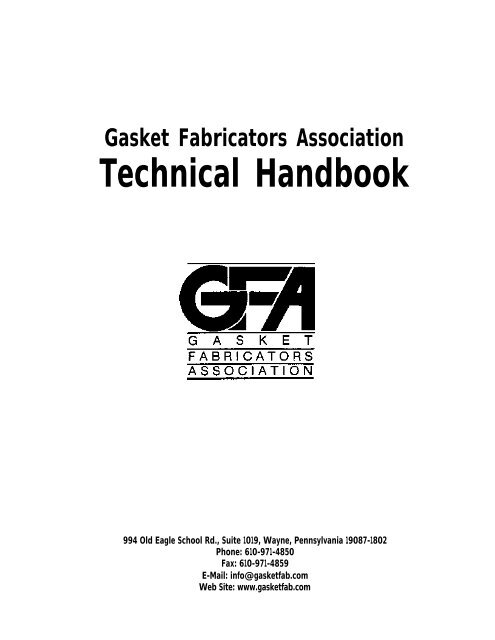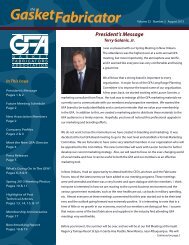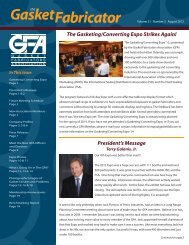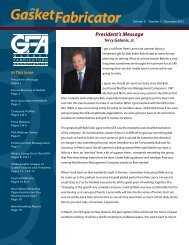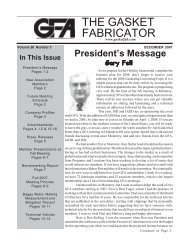Technical Handbook - Gasket Fabricators Association
Technical Handbook - Gasket Fabricators Association
Technical Handbook - Gasket Fabricators Association
You also want an ePaper? Increase the reach of your titles
YUMPU automatically turns print PDFs into web optimized ePapers that Google loves.
<strong>Gasket</strong> <strong>Fabricators</strong> <strong>Association</strong><br />
<strong>Technical</strong> <strong>Handbook</strong><br />
994 Old Eagle School Rd., Suite 1019, Wayne, Pennsylvania 19087-1802<br />
Phone: 610-971-4850<br />
Fax: 610-971-4859<br />
E-Mail: info@gasketfab.com<br />
Web Site: www.gasketfab.com
©Copyright 1998 - <strong>Gasket</strong> <strong>Fabricators</strong> <strong>Association</strong><br />
994 Old Eagle School Road, Suite 1019<br />
Wayne, PA 19087-1866<br />
No duplication without the written consent of the <strong>Gasket</strong> <strong>Fabricators</strong> <strong>Association</strong>
Table of Contents<br />
I Introduction<br />
A. <strong>Gasket</strong> Fabricator Definition------------------------------ 1<br />
B. Types of Materials Fabricated - Processing Equipment-1<br />
II Standard Practices------------------------------------------3<br />
A. Dimensional Characteristics------------------------------- 3<br />
B. Material Thickness Tolerances----------------------------10<br />
C. Measurement------------------------------------------------11<br />
D. Part Identification-------------------------------------------12<br />
E. Labeling (Standard Label Format)------------------------13<br />
F. Lot Traceability--------------------------------------------- 14<br />
G. Quality Assurance------------------------------------------15<br />
H. Statistical Process Control---------------------------------15
INTRODUCTION<br />
<strong>Gasket</strong> Fabricator Defined<br />
<strong>Gasket</strong>s are an integral component<br />
of any device which<br />
requires the confinement of a<br />
gas or liquid. They compensate for the<br />
unconformity of mating surfaces.<br />
These surface irregularities may be<br />
minute or large depending on the<br />
purpose of the device but in all cases,<br />
the gasket is required to compensate<br />
for the difference while limiting the<br />
flow of fluid in either direction.<br />
<strong>Gasket</strong>s differ from seals in that<br />
gaskets are normally cut from sheets or<br />
rolls while seals are formed individually<br />
in their own configuration. A flat<br />
cut gasket is derived from material of<br />
specific thickness and to a configuration<br />
that is designed for a specific<br />
application.<br />
Organizations which convert<br />
material in sheet or roll form to functional<br />
gaskets are designated as “gasket<br />
fabricators,” gasket cutters,” or simply<br />
“converters.” “<strong>Gasket</strong> fabricators” are<br />
generally perceived to be those organizations<br />
which have dedicated their<br />
assets toward optimal accuracy and<br />
efficiency in their gasket fabricating<br />
activities. They have made major investments<br />
in sophisticated fabricating equipment.<br />
<strong>Gasket</strong> fabrication for original<br />
equipment production line applications<br />
requires consistency and precision on an<br />
ever-improving scale. Organizations that<br />
are sensitive to these needs, invest in the<br />
required equipment and process controls.<br />
Members of the <strong>Gasket</strong> <strong>Fabricators</strong><br />
<strong>Association</strong> are professionals dedicated<br />
to the continuous improvement of<br />
these activities.<br />
1<br />
Types of Material<br />
Fabricated—Processing<br />
Equipment<br />
If the gasket material is in sheet or<br />
roll form, a gasket fabricator can<br />
convert it into parts. However,<br />
the material characteristics will determine<br />
the personality of the end product.<br />
<strong>Gasket</strong> materials that are hard<br />
and thin can be fabricated to tighter<br />
dimensional tolerances than gasket<br />
materials that are soft and thick.<br />
Accordingly, 90 durometer rubber 1 /32<br />
inch thick can be cut to more precise<br />
requirements than 30 durometer<br />
rubber 1 /8 inch thick.<br />
Some gasket fabricators specialize<br />
in certain types of material. One<br />
fabricator may have unique capabilities<br />
in the processing of sponge rubber<br />
products where another fabricator<br />
may have acquired equipment more<br />
suitable for elastomeric rubber.<br />
Another specialization is the<br />
ability to process sheets rather than<br />
roll goods. One fabricator may be<br />
heavily invested in platen presses<br />
while another may specialize in slitters<br />
and punch presses with continuous<br />
feed and takeoff.<br />
Typical gasket fabricating equipment<br />
utilized by gasket fabricators<br />
are:<br />
1. Steel Rule Dies— Most commonly used<br />
for moderate volume parts. Tooling<br />
is economical and can be used<br />
in platen presses, roll presses,<br />
mechanical presses or rotary die<br />
machines.
2. Male and Female Blanking Dies—Generally<br />
used in high volume production<br />
where very close tolerances are<br />
required. Tooling is more costly<br />
but generally longer lasting.<br />
3. Laser Cutting Machines—Laser technology<br />
offers excellent tolerance control with<br />
essentially no tooling wear. Equipment<br />
is expensive and used primarily<br />
in very specific applications.<br />
4. Water Jet Cutting Machines—New technology<br />
with limited use, except in<br />
reinforced fiberglass composite<br />
cutting. Offers excellent tolerances.<br />
5. Wire Electrical Discharge Machines (EDM)—<br />
For small volume or prototype<br />
work. Very good for intricate<br />
designs.<br />
In summary, all gasket fabricators<br />
are not alike. They differ in their converting<br />
capabilities and accordingly, they<br />
differ in the types and forms of materials<br />
processed.<br />
2
STANDARD PRACTICES<br />
DIMENSIONAL CHARACTERISTICS<br />
General<br />
The objective of the following<br />
specifications and capabilities<br />
for cut gaskets is to acquaint the<br />
user of gasketing products with acceptable<br />
methods, procedures and dimensional<br />
characteristics used in the industry.<br />
The enclosed information and data is<br />
offered as a guide to the designer of<br />
gaskets as well as an aid to the purchasing<br />
facility using cut gaskets.<br />
The specifications outlined herein<br />
were developed from the present state<br />
of the art with respect to known manufacturing<br />
techniques. Depending upon<br />
materials, product design and/or<br />
individual manufacturing techniques,<br />
the dimensional specifications outlined<br />
in the report may vary.<br />
Application<br />
In general, a gasket is used to seal<br />
two imperfect mating surfaces. In<br />
any part designed as a gasket, only<br />
the designer knows which dimensions<br />
are critical. If all are critical, this<br />
should be clearly indicated. In gasket<br />
designs, the bolt hole location and hole<br />
size are normally the most important.<br />
Port hole position and size may also be<br />
of prime concern. Thickness of the<br />
gasket as well as the material physical<br />
characteristics play an important part<br />
in gasket design and capability. The<br />
essential design elements should<br />
always be specified on drawings. In<br />
examining a gasket drawing the producer<br />
of a gasket frequently questions<br />
if corners must be as sharp as shown<br />
3<br />
or whether radii are acceptable; do all<br />
holes and ports actually require the<br />
same close tolerances; and does the<br />
title block tolerance properly reflect<br />
actual gasket requirements versus<br />
standards for machined parts? The<br />
designer should be certain he needs<br />
everything he specifies. Unnecessary<br />
requirements can result in needless<br />
costs in producing the parts. Consultation<br />
with the gasket fabricator will<br />
often lead to cost saving in tooling or<br />
production of the part.<br />
Methods<br />
Although cutting methods for<br />
individual gaskets can vary<br />
widely, the most conventional<br />
cutting tools used are: Steel rule dies,<br />
solid steel dies, or a combination of<br />
both. The most widely used is the steel<br />
rule die. Steel rule dies have been<br />
described as “glorified cookie cutters.”<br />
A steel rule die consists of a base<br />
material such as high grade plywood or<br />
phenolic composition which becomes<br />
the holder for a strip of hard thin steel<br />
sharpened on one edge known as “steel<br />
rule.” Sharpened hole punches known<br />
as “tubes” are incorporated along with<br />
rubber stripper pads to complete the<br />
tool. Depending upon the dimensional<br />
aspects of the part, different procedures<br />
can be used in the construction of the<br />
cutting tool. These various methods<br />
greatly dictate the accuracy of the cut<br />
part.<br />
The illustrations on page 7 and 8<br />
outline steel rule construction methods.
Tooling Types<br />
The two most common types of<br />
tooling used are steel rule dies and all<br />
steel dies. Volume, quantity, tolerance,<br />
and cost are the variables that help<br />
determine the type of tooling used.<br />
Steel Rule Dies<br />
There are multiple ways to construct a<br />
steel rule die. However, the objective of<br />
any method is to cut a pattern of the part<br />
into the base material, and then insert a<br />
steel rule that has been bent into the<br />
same pattern, into the base material.<br />
The various methods used to<br />
make a steel rule die are:<br />
To obtain the pattern cut into the<br />
dieboard, the customer’s print or part<br />
pattern can be either hand or machine<br />
drafted onto the dieboard. The<br />
dieboard is then hand cut with a<br />
jigsaw.<br />
Another method is to program the<br />
customer’s print into a computer<br />
controlled laser cutting machine and<br />
laser cut the pattern into the dieboard.<br />
Once the pattern is cut into the<br />
dieboard, the steel rule is bent into the<br />
same pattern and inserted into the<br />
board. The bending of the steel rule<br />
can be done either by hand or by using<br />
a computer driven rule bending<br />
machine.<br />
As shown in the chart on the<br />
following page, these methods have<br />
different tolerances associated with<br />
them.<br />
All Steel Tooling<br />
Depending upon the complexity<br />
of the design, the type of material and<br />
the volume of the part, all steel male<br />
and female tooling is often used to<br />
produce a gasket. Unlike blanking or<br />
cutting ferrous or nonferrous materials,<br />
most gasketing materials do not<br />
require clearance between the punch<br />
and the die in all steel tooling. The<br />
common practice is to construct all<br />
steel tooling with minimum clearance<br />
between the punch and die. In many<br />
instances, the punch may be hard with<br />
a soft die which allows the die to be<br />
“peened” against the punch to provide<br />
zero clearance conditions. Zero clearance<br />
provides clean cut parts. As the<br />
edges of the punch and die become<br />
rounded due to the abrasive action of<br />
the material being cut, the quality of<br />
the cut part may diminish.<br />
Dimensional tolerancing for all<br />
steel tooling can be controlled to a few<br />
thousandths of an inch. The improved<br />
accuracy of all steel tooling over rule<br />
die tooling results in more accurate<br />
part dimensional capabilities. Although<br />
the all steel tooling used to produce a<br />
gasket may be built to very close<br />
tolerances, the tolerance of the part<br />
depends upon the gasketing material.<br />
The material may pull or stretch during<br />
the cutting action. The cut part may be<br />
subject to shrinkage or expansion<br />
depending on the atmospheric conditions<br />
after cutting. To maintain maximum<br />
dimensional stability on parts<br />
produced from all steel tooling, the die<br />
should be maintained in a sharp condition<br />
and the parts should be packaged<br />
in a stable environment.<br />
4
Dimensional Capabilities for Steel Rule Dies<br />
It is important to know that the dimensions of the die<br />
cut part are determined not only by the die, but also by<br />
the material type, hardness, density, thickness, and<br />
variations of these factors. The greater the variation of<br />
these factors, the greater the variance of the die cut dimensions.<br />
Different types of tooling have different dimensional<br />
tolerances.<br />
All steel tooling provides the most accurate tolerances.<br />
These can vary depending on type of tool construction<br />
methods, but generally +/-.002 to +/-.005 can be held.<br />
Steel rule tooling also varies with the type of construction<br />
method. The most accurate is laser cut board with<br />
automated bent rule. Depending on length of rule, tolerances<br />
can range from +/-.005 to +/-.015. The longer the rule<br />
is, the more variation can be expected.<br />
Steel rule dies that are laid out by hand and jigsaw cut<br />
can not be held this tight and will generally vary +/-.030.<br />
Holes that are cut using punches will have the same<br />
tolerance regardless of die construction method. The<br />
industry accepted variation on punch dimensions are as<br />
follows:<br />
Hole diameter—less than 3 /4” +/-.002<br />
Hole diameter—from 3 /4”-1 5 /8 +/-.003<br />
Hole diameter—greater than 1 5 /8 +/-.005<br />
Hole position tolerance is again best achieved using<br />
laser cutting and automated rule bending. Depending on<br />
distance between holes +/-.005 to +/-.015 can be expected. If<br />
the die is laid out by hand and jigsaw cut, the tolerances<br />
could be +/-.010 to +/-.030.<br />
These tolerances are general guidelines and can vary<br />
based upon die building equipment and the skills of the die<br />
maker.<br />
5
Steel Rule Die Making Methods<br />
A computer controlled laser cuts<br />
the die board.<br />
The die making process begins with the layout. The layout can be<br />
done either manually or by C.A.D.<br />
6<br />
The pattern is cut with a precision<br />
jig saw.
The steel rule is<br />
hand cut and bent<br />
to proper configuration.<br />
(Right) A computer<br />
controlled<br />
machine cuts and<br />
bends the rule.<br />
7<br />
The steel rule is inserted into the<br />
die board.<br />
The steel rule die is complete.
Single Bevel Double Bevel Double<br />
Double Bevel<br />
Single<br />
Double<br />
Bevel<br />
Creasing<br />
Rule<br />
Dimensional Verification<br />
Various methods are used to check dimensions on<br />
production tooling or parts. In most cases, it is difficult to<br />
measure the dimensions on the steel rule die itself, because<br />
of the many types of bevels and position of the cutting edge.<br />
It is not recommended to use the gasket as a measuring<br />
device since the part is usually flimsy and unstable. Some<br />
gasket materials are subject to change due to atmospheric<br />
conditions, such as humidity.<br />
Die impressions are commonly used to check dimensions.<br />
The impression should be made on stable material.<br />
These materials are not subject to change due to temperature<br />
or moisture conditions. Mylar, plastics and tag paper<br />
are commonly used. An impression is created by either<br />
cutting partially into the plastic material, which gives a clear<br />
defined line to measure against, or a dark line impression<br />
can be obtained by placing carbon paper between the die<br />
and manila tag. If a coordinate measuring machine is used<br />
for checking, the plastic impression is best to use since a<br />
defined line is present in which to position the stylus. Caution<br />
should be used when making the impression. Distortion<br />
can result if the impression is too deep which can cause<br />
errors in measurement.<br />
Manila tag impressions can be easily measured using<br />
standard drafting techniques or they can be used with<br />
coordinate measuring machines similar to plastic impressions.<br />
Punched holes dimensions should be measured by<br />
means of plug gauges in the punched hole of the gasket.<br />
The hole should be measured opposite the initial pierced<br />
side. On relatively thin materials, there will be little, if any,<br />
size variation from one side or the other. On thick materials,<br />
the bevel of the punch tube may distort the hole to some<br />
degree.<br />
Hole true position can best be determined by coordinate<br />
measuring machines. All positional tolerance requirements<br />
are to be based upon maximum material conditions<br />
(MMC) unless otherwise specified.<br />
An example of hole location tolerance for floating<br />
fasteners and tolerances for radius with an unlocated center<br />
is illustrated at the top of the next page.<br />
8
Toleranced Radii.<br />
A toleranced radius with an unlocated center creates a<br />
tolerance zone defined by arcs tangent to adjacent surfaces<br />
within which the part contour must have a faired curve<br />
without reversals. The part contour falls entirely within the<br />
zone between the minimum radius and the maximum<br />
radius, regardless of the actual shape of the part. The<br />
radius at all points of the part contour shall neither be<br />
smaller than the specified minimum limit nor larger than the<br />
maximum limit. See illustration.<br />
9
MATERIAL THICKNESS TOLERANCES<br />
To perform their function, gaskets are expected to be compressible and<br />
resilient. Materials are often selected for specific applications because<br />
of their compressibility.<br />
Since the material is intended to be compressed, original thickness and<br />
thickness tolerances are important only to the extent that sufficient material<br />
remains after compression to fill the gap between flange surfaces. Accordingly,<br />
in general, soft compressible materials (sponge, cork) have greater thickness<br />
tolerances than firm, less compressible materials (compressed sheet). In no case<br />
should these resilient materials be specified with the same thickness tolerances<br />
as non-resilient materials such as steel.<br />
Typical thickness tolerances for resilient gasketing materials are listed<br />
below.<br />
10
MEASUREMENT<br />
In the previous section “Dimensional Characteristics,” it was suggested that<br />
dimensional verification of tooling be made on die impressions rather than<br />
on cut gaskets due to the dimensional instability of some materials. This<br />
procedure may be acceptable in the fabricator’s workplace but it may not satisfy<br />
the needs of the gasket user. Accordingly, attention must be given to the gasket<br />
dimensions at the place of application. If the gasket material shows significant<br />
dimensional change in changes of atmospheric conditions, the gasket must be<br />
protected from these influences. In recognition of this characteristic, gaskets<br />
fabricated from cork containing materials are generally packaged in polyethylene<br />
bags. Although cellulosic materials are subject to dimensional change in varying<br />
environmental conditions, some cellulose based materials have been reinforced<br />
with inorganic fibers to reduce atmospheric dimensional change.<br />
Notwithstanding the above information, there are times when fabricated<br />
gaskets must be checked for their dimensional conformance to blueprint or<br />
application requirements. In order to achieve verifiable and accurate dimensions,<br />
consideration must be given to atmospheric conditioning of the gasket.<br />
ASTM Standard F104-83, Paragraph 8, details the currently accepted conditioning<br />
practices.<br />
Measuring devices available and commonly used by gasket fabricators are:<br />
Calipers<br />
Coordinate Measuring Machines<br />
Durometer Gage - instrument to check hardness of rubber and rubberlike<br />
material<br />
Gage Pins - straight, unflanged pins with specific diameters and extremely<br />
close tolerances<br />
Light Section Microscope<br />
Metal Hardness Tester-device to determine hardness of steel being<br />
fabricated<br />
Micrometers<br />
Optical Comparators<br />
Radius Gages - precision ground metal strips with accurate radius<br />
machined on each end<br />
Scales - 6” 12” 18”<br />
Shadow Graph Machines<br />
Templates - Soft (thin plastic or mylar) Hard (1/8” to 1/2” thick plastic<br />
or mylar with steel pins)<br />
Tolerance Gauge - Tool for visual pass/fail dimensional inspection.<br />
11
PART IDENTIFICATION<br />
Some manufacturing operations utilize a multitude of similar gaskets.<br />
Accordingly, it is frequently desirable to individually identify different<br />
parts by number and/or supplier. This identification provides for:<br />
1) Traceability<br />
2) Inventory Verification<br />
3) Efficient Application<br />
There are a number of identification alternatives which can be arranged. Among<br />
them:<br />
1) Rubber Stamp with ink - Part Number and/or Supplier Logo<br />
2) Metal Stamp - No ink - Indent Material with Part Number and/or Supplier Logo<br />
3) Screen Print - Part Number and/or Supplier Logo<br />
4) Tie In Bundles and Tag<br />
5) Package Specific Quantities in Printed Envelopes<br />
6) Shrink Pack Specific Quantities - Label<br />
7) Color Code with Rubber Stamp or Screen Printing<br />
8) Notch Edge of <strong>Gasket</strong> According to Prearranged Code<br />
NOTE: Special operations may add to cost of gasket.<br />
12
LABELING<br />
Effective labeling is an important component of good customer/supplier<br />
relationships. It is important that labels be placed for easy viewing from<br />
any vantage point, they must be visually clean, and they must include all<br />
of the information pertinent to the transaction.<br />
In many cases, all of the required information cannot be provided and<br />
should not be provided on the same label. Many companies prefer shipping<br />
information be separated from product information. In other cases, format is the<br />
prime consideration. In any case, these details can always be negotiated between<br />
customer and supplier. Typical labels are as follows:<br />
13
LOT TRACEABILITY<br />
Lot Traceability System<br />
<strong>Gasket</strong> manufacturers should establish a system for positive identification<br />
and record keeping for use when required by customers. The lot identification<br />
number for finished gaskets should provide traceability to major manufacturing<br />
operations, inspection, testing, and significant raw materials. The method of lot<br />
control and identification should be developed by the gasket manufacturer,<br />
consistent with their manufacturing facilities and operations, and should include<br />
the elements discussed below.<br />
Lot Identification<br />
The lot identification and lot size should be determined by one of the major<br />
manufacturing, testing or inspection operations. Significant raw materials may<br />
also be considered for lot size and identification. In continuous operations, it<br />
may be necessary to select a specific length of time, such as a shift, one day, one<br />
week, etc. to determine lot size. In all cases, the lot number assigned to finished<br />
gaskets must provide traceability to major manufacturing operations, inspection<br />
and test records and significant raw materials.<br />
The gasket supplier should assign only one lot code to a lot, regardless of<br />
the number of shipping designations. When successive subdivisions of the lot are<br />
necessary, the principal code must be supplemented by additional subordinate<br />
codes to identify each of the sublots. Each shipping container must be identified<br />
with the principal and subordinate codes.<br />
The supplier may ship more than one lot on a pallet, but each container on<br />
the pallet must contain parts from only one lot. The packing slip must state the<br />
number of containers comprising each lot.<br />
Lot Traceability Control<br />
The gasket supplier must establish a system for identifying lots so that:<br />
· Records indicating inspection or tests results contain the principal and subordinate<br />
lot code.<br />
· The final inspection reports are cross-referenced to supporting inspection and<br />
test documents and the supplier’s code.<br />
14
QUALITY ASSURANCE<br />
Policy<br />
<strong>Fabricators</strong> will employ appropriate operating procedures and controls to<br />
assure that parts supplied conform to customer specification requirements.<br />
Procedures<br />
A. <strong>Fabricators</strong> will establish and maintain written procedures covering all<br />
phases of the control system. These procedures will be dated and signed by an<br />
authorized individual and will be available for review by customer representatives.<br />
B. Records of conformance will be retained for 12 months, or as required<br />
by the customer after shipment of parts. Retained records will include:<br />
Supplier evidence of conformance to specification<br />
Fabricator evidence of manufacturing process capability<br />
X and R Charts of critical characteristics<br />
References<br />
Harvey C. Charbonneau and Gordon L. Webster. Industrial Quality<br />
Control, Prentice-Hall, Inc. 1978<br />
Eugene L. Grant and Richard S. Leavenworth . Statistical Quality<br />
Control, McGraw-Hill, Inc. Fifth Edition, 1980.<br />
J.M. Juran, Frank M. Gryna, Jr., and R.S. Bingham, Jr. Quality<br />
Control <strong>Handbook</strong>, McGraw-Hill, Inc., Third Edition, 1979.<br />
H. STATISTICAL PROCESS CONTROL (S.P.C.)<br />
S.P.C. provides a means for changing the emphasis of quality control from<br />
detection of defects to prevention of defects.<br />
S.P.C. operates by:<br />
Returning control of quality to the place where it starts; the operator, tool<br />
setter, supervisor.<br />
Detecting changes in process at the earliest possible point.<br />
Providing sound knowledge of reasons for a process change.<br />
Determining the inherent variations in a process.<br />
S.P.C. provides:<br />
Knowledge of the place and time to take corrective action and avoid<br />
continued production of bad parts.<br />
A road map which enables a manufacturer to better his process.<br />
Results of a good S.P.C. program are:<br />
Improved customer satisfaction.<br />
More realistic processes and tolerances on any given product.<br />
A formal program for “best of quality” output.<br />
Lower costs.<br />
15
994 Old Eagle School Rd., Suite 1019, Wayne, Pennsylvania 19087-1866<br />
Phone: 610-971-4850<br />
Fax: 610-971-4859<br />
E-Mail: info@gasketfab.com<br />
Web Site: www.gasketfab.com


